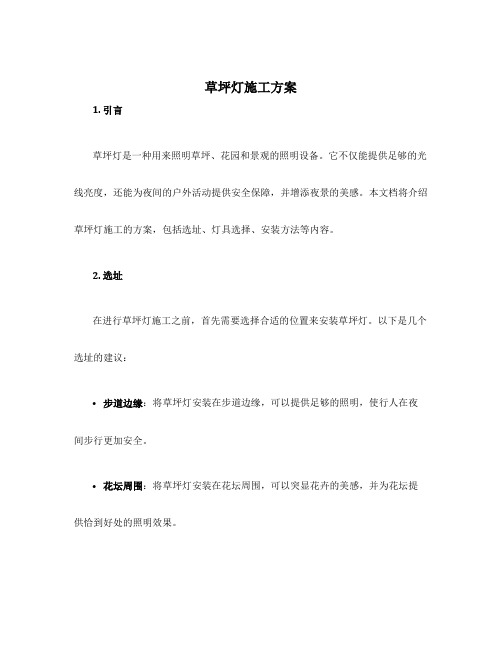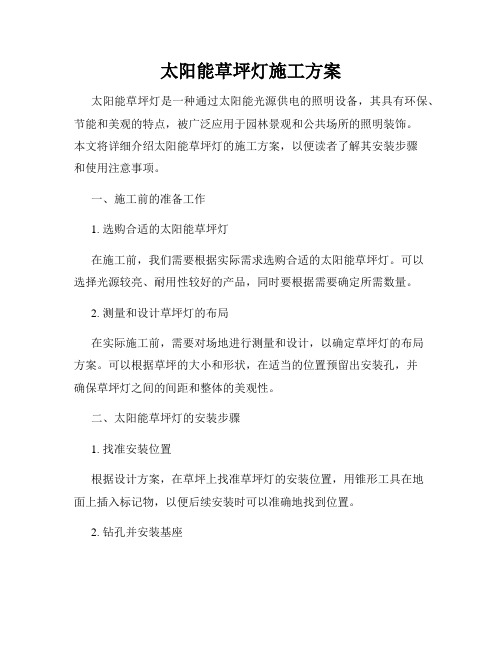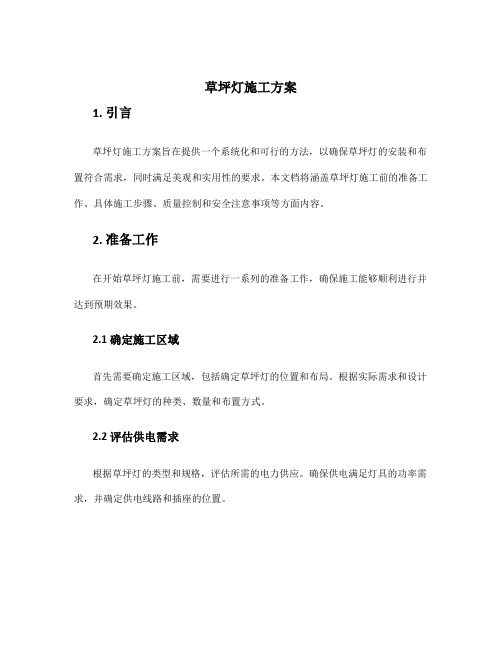室外草坪灯的安装说明
草坪灯施工方案

草坪灯施工方案草坪灯的施工方案是指在草坪上安装草坪灯的具体步骤和方法,下面是一个关于草坪灯施工方案的700字说明:草坪灯是一种用于室外草坪的照明设备,通过将草坪灯安装在草坪上,可以提供良好的照明效果,同时也增加草坪的美观性。
草坪灯施工方案主要包括以下几个步骤:规划布局、施工准备、安装灯具、连接线路、调试效果等。
首先,规划布局是草坪灯施工方案的第一步。
根据草坪的形状和大小,确定草坪灯的布置位置和数量。
一般来说,草坪灯应平均分布在整个草坪上,保证照明效果均匀。
接下来是施工准备。
施工前应在草坪上清除杂物和垃圾,确保施工环境整洁。
还应准备好所需的工具和材料,如灯具、电缆、电焊机等。
同时,对于大型项目,还需要制定详细的工程计划,确定施工时间和进度。
然后是安装灯具。
根据规划布局确定的位置,使用专用工具在草坪上挖孔,将草坪灯固定在孔中。
灯具的安装高度要合适,既要保证照明效果,又要避免灯具遭到破坏。
在安装过程中,还应注意排水和防水措施,以保证灯具的正常使用寿命。
接下来是连接线路。
根据草坪灯的位置和布局,敷设电缆,并连接好灯具和电缆。
要确保电缆安全可靠,避免发生漏电和短路等事故。
连接线路时,应注意电缆的绝缘和防护,以防止电缆受损。
最后是调试效果。
在完成灯具的安装和线路的连接后,需要对草坪灯进行调试。
通过接通电源,观察灯具的照明效果和亮度是否满足要求。
如有需要,可以进行灯光的调整和优化,以达到良好的照明效果。
总之,草坪灯施工方案包括规划布局、施工准备、安装灯具、连接线路和调试效果等步骤。
通过科学合理的施工方案和严格的操作,可以保证草坪灯的安装质量和使用效果。
同时,草坪灯的施工应遵守相关规范和安全操作技术,确保施工过程中的安全和稳定。
草坪灯施工方案

草坪灯施工方案1. 引言草坪灯是一种用来照明草坪、花园和景观的照明设备。
它不仅能提供足够的光线亮度,还能为夜间的户外活动提供安全保障,并增添夜景的美感。
本文档将介绍草坪灯施工的方案,包括选址、灯具选择、安装方法等内容。
2. 选址在进行草坪灯施工之前,首先需要选择合适的位置来安装草坪灯。
以下是几个选址的建议:•步道边缘:将草坪灯安装在步道边缘,可以提供足够的照明,使行人在夜间步行更加安全。
•花坛周围:将草坪灯安装在花坛周围,可以突显花卉的美感,并为花坛提供恰到好处的照明效果。
•草坪边缘:将草坪灯安装在草坪边缘,可以为整个草坪提供均匀的照明,使其在夜间更加美丽。
在选址时,需要注意以下几点:•光照均匀性:要保证草坪灯的照明范围覆盖均匀,不要出现明暗不均的情况。
•不遮挡视线:草坪灯的选址不应遮挡人们的视线,影响视觉安全。
3. 灯具选择草坪灯的种类繁多,根据需要可选择不同功率和类型的灯具。
以下是几种常见的草坪灯:•太阳能草坪灯:利用太阳能进行充电,无需电源线,适合安装在户外环境。
•LED草坪灯:具有节能、寿命长、亮度高等优点,使用寿命可达到50000小时以上。
•卤钨灯草坪灯:亮度较高,但耗电量相对较大,适合需要较高亮度照明的场所。
在选择灯具时需要考虑以下几点:•照明需求:根据需要确定草坪灯的亮度、颜色、照明范围等参数。
•能源消耗:考虑草坪灯的能源消耗情况,选择节能型灯具以减少能源消耗。
•寿命和维护:了解灯具的寿命和维护情况,选择易于维护和更换的灯具。
4. 安装方法在安装草坪灯时,需要按照以下步骤进行:1.测量和标记:在选址确定后,使用测量工具测量出灯具安装的位置,并进行标记。
2.挖掘坑口:根据灯具的尺寸,使用挖掘工具挖掘出适当大小的坑口,用于安装灯具。
3.埋设电缆:将电缆从电源连接到草坪灯的安装位置,需要保证电缆不被损坏。
4.安装草坪灯:将草坪灯按照说明书的要求正确安装到预先挖好的坑口中,并调整位置。
5.灯具连接:将灯具与电缆连接,确保连接牢固,防止因松动而引起短路等安全问题。
太阳能草坪灯施工方案

太阳能草坪灯施工方案太阳能草坪灯是一种通过太阳能光源供电的照明设备,其具有环保、节能和美观的特点,被广泛应用于园林景观和公共场所的照明装饰。
本文将详细介绍太阳能草坪灯的施工方案,以便读者了解其安装步骤和使用注意事项。
一、施工前的准备工作1. 选购合适的太阳能草坪灯在施工前,我们需要根据实际需求选购合适的太阳能草坪灯。
可以选择光源较亮、耐用性较好的产品,同时要根据需要确定所需数量。
2. 测量和设计草坪灯的布局在实际施工前,需要对场地进行测量和设计,以确定草坪灯的布局方案。
可以根据草坪的大小和形状,在适当的位置预留出安装孔,并确保草坪灯之间的间距和整体的美观性。
二、太阳能草坪灯的安装步骤1. 找准安装位置根据设计方案,在草坪上找准草坪灯的安装位置,用锥形工具在地面上插入标记物,以便后续安装时可以准确地找到位置。
2. 钻孔并安装基座使用电钻在所标记的位置上钻孔,并确保孔的深度适当。
然后在孔内放入基座,确保其与地面齐平。
3. 连接电源线将太阳能草坪灯的电源线通过基座的孔穿出,确保连接牢固。
根据实际情况,可以选择埋线或隐藏线的方式进行布线。
4. 安装太阳能电池板将太阳能电池板固定在光照充足的位置,比如房顶或周围没有遮挡物的地面。
确保电池板正面朝向太阳,以获得更好的光照效果。
5. 连接电池板和草坪灯将太阳能电池板的电源线与草坪灯的电源线进行连接,并确保连接稳固。
这样太阳能光源才能为草坪灯提供稳定的电力。
6. 放置草坪灯将草坪灯放置在基座上,并确保其稳固。
根据实际需要,可以调整灯具的角度和位置,以获得理想的照明效果。
7. 完成布线和调试完成以上步骤后,检查所有电线的连接是否稳固,并进行调试。
确保草坪灯能够正常工作,并具有良好的照明效果。
三、太阳能草坪灯的使用和维护1. 使用注意事项在使用太阳能草坪灯时,注意保持电池板的清洁,以确保光照的充足和稳定。
同时,避免灯具的长时间亮度过高,以延长使用寿命。
2. 定期检查和维护定期检查草坪灯的电源线和连接是否松动,如有问题需要及时修理。
YHCPAA12 型草坪灯灯芯安装使用说明

YHCPAA12型草坪灯灯芯安装使用说明1、使用说明本灯芯包含LED光源,LED恒流驱动电源和LED散热体。
灯芯可与目前市场上多数较为流行的草坪灯灯壳相匹配。
安装完毕后,按产品名牌上标明的电源电压要求,接通电源即可发光。
光源正常使用过程中无须更换。
如一盏灯具中发生多个光点不亮时,可进行维修。
2、技术指标型号:YHCPAA12;电源电压:AC 220V,85~250V,DC24V;最大功率:15W;功率因数:≥0.6;3、应用场所:广场、草地(坪)、公园、别墅、城市景观照明等。
4、LED系列草坪灯灯芯特点:a、使用寿命超长,维护成本极低;b、功耗低,高亮度,不发烫,低压电路与市电完全隔离,使用安全,绿色环保;c、色彩多样,并可选择七彩变色。
d、投射角度可变,可选择360度或半球形辐射。
e、安装灵活方便。
5、规格说明本系列灯芯系采用12颗1W大功率LED作为光源,配以隔离的AC-DC恒流驱动电源,DC24V供电时采用DC-恒流驱动电源。
其外形尺寸为:L 50mm,W50mm,H80mm;灯体由铝材挤压成形。
相关尺寸型号Model尺寸Dimension(mm)L×W×H单个包装尺寸(mm)Single Packing SizeL×W×H外包装尺寸(mm)Outside Packing SizeL×W×H装箱数量Quantites(pcs/ctn)YHCPAA1250×50×80/360×300×9020电参数表型号Model额定电压V oltage(V)频率Frequency(Hz)最大功率Max Power(W)功率因数PF(λ)LED光通量*luminous flux(lm)温升Δt(℃)AC220V50 15 0.6 ≥420≤40YHCPAA12DC24V DC 15 / ≥420≤40* 系指白光LED发出的总的光通量,不含灯具效率。
草坪灯施工工艺

草坪灯施工工艺概述草坪灯施工工艺是指在草坪或庭院中安装和布置草坪灯具的过程。
良好的施工工艺可以确保草坪灯的稳固性和美观性。
本文档旨在介绍一种常用的草坪灯施工工艺。
施工步骤以下是草坪灯施工的一般步骤:1. 规划和设计在施工前,需要进行规划和设计草坪灯的布局。
需要考虑灯具的种类、数量和位置,以及电缆的敷设路径等。
可以制作简单的示意图来帮助规划。
2. 确定灯具位置根据设计方案,确定草坪灯的具体位置。
使用标杆或丝线可以帮助标记灯具的准确位置。
3. 挖掘灯孔用挖掘工具挖掘灯孔,确保孔的深度和直径适合灯具的安装。
注意不要损坏地下管道和电缆。
4. 安装灯具和电缆将灯具安装到灯孔中,确保它们牢固稳定。
然后,将电缆从灯具引出,并埋入地下,到达下一盏灯的位置。
电缆连接处应采取防水措施,以确保电缆的安全。
5. 连接电源和测试将电缆与电源连接,并进行测试,确保所有草坪灯都能正常工作。
如果有故障或异常,及时修复。
6. 固定和调整灯具确保所有灯具都固定在预定的位置,并调整其角度和方向,以获得最佳的照明效果。
注意事项- 在施工过程中,要遵循安全操作规定,确保工作人员和设备的安全。
- 在挖掘灯孔时,应小心处理土壤和灌木植物,以防止损坏周围环境。
- 电缆敷设时,要保持整齐和有序,避免交叉和绕圈。
- 为了保护灯具和电缆,可以在灯孔周围填充一定的沙土。
总结良好的草坪灯施工工艺可以确保草坪灯的美观和稳定性。
在施工过程中,按照规划和设计的要求,依次完成灯具安装、电缆敷设和测试,并注意安全和环境保护的要求。
草坪灯安装间距一般是多少?

坚持质量第一,信誉第一草坪灯安装间距一般是多少?草坪灯产品在照明领域运用广泛,但对于很多初次接触的人来讲并不了解,小编在此给您盘点草坪灯知识,希望对您有所帮助。
1、草坪灯安装—草坪灯安装的一般步骤草坪灯在进行安装的时候,要打开灯壳,安装光源及配套电器,把引出线由穿线孔引出至灯杆底部,然后把灯头与灯杆链接,注意拧紧紧固螺丝,然后把草坪灯法兰与基础预埋件螺杆对齐,垂直站立。
然后使用螺母或垫平找平后即可拧紧安装螺母。
2、草坪灯安装—草坪灯安装布线要注意安全可靠的接地草坪灯在布线时,应用一根不小于配电相线的电线作为接地线来连接灯具或灯柱的金属外壳,地线接系统的“地”。
当接地线长度超过25米时,末端做一次重复接地,重复接地可以埋一根4mmx40mm,长25米的镀锌扁铁,打5 个接地极,接地极采用5x50的镀锌角钢,长2.5米,垂直打入地下,接地极与镀锌扁铁均距离焊接,要求接地电阻小于4欧。
灯杆的接地极必须焊接牢固,接头处搪锡,路灯电源的PE 保护线与灯杆接地线连接时必须用弹簧垫片压顶后再拧上螺母。
比如说大于25米的时候,我们就需要在末端再做一次重复的接地,那么重复接地的话是需要埋一根4mmx40mm,长度是25米的镀锌扁铁,同时还需要打上5 个接地极,垂直的打入地下之后,再进行焊接。
3、草坪灯安装—草坪灯安装要注意间距灯具使用高0.5米,23瓦的节能灯要求间距在11米左右,这样照明效果最佳,能节约大量成本。
庭院灯间距在25米左右,草坪灯视具体情况和要求而定,有的假山、亭子周围的地方会装的多一些。
草坪灯安装是一个需要考虑多个方面的问题,用户在具体安装的时候,还一定要注意好了,要挑选到质量好的灯具,特别是在比较潮湿的地方,更要挑选具有一定防范作用的灯具。
安装好了草坪灯,能保证安装效果好,而且还能起到安全的效果,让使用效果得到更好展现。
4、草坪灯装饰城市的作用草坪灯的光线较为柔和,而且色彩也比较多样,并且现在随着设计的不断跟进,随着人们需求的不断提升,当前设计造型比较多,外形比较理想,白天的时候能起到不错的装饰性作用,而晚上的时候,也是非常美观大方的,给人以美感。
太阳能草坪灯施工方法

太阳能草坪灯施工方法
太阳能草坪灯的施工方法主要包括以下步骤:
1. 清理现场:在安装前,需要清理场地,确保没有杂物和障碍物。
2. 定位:根据设计图纸和现场实际情况,确定灯具的安装位置,并在地面上做出标记。
3. 预埋:根据灯具的尺寸和重量,预先埋设好相应的基础或支架,以确保灯具的稳固性和安全性。
4. 接线:根据灯具的接线要求,将电源线或数据线正确连接在相应的接口上,确保连接牢固可靠。
5. 安装:将灯具固定在预定的位置上,确保灯具安装平稳、牢固。
6. 调试:安装完成后,需要对灯具进行调试,确保其正常工作并达到预期的照明效果。
7. 维护:定期对灯具进行清洁和维护,以延长其使用寿命和保持其良好的照明效果。
需要注意的是,在施工过程中,应遵循安全操作规程,特别是在接线和安装过程中,要确保电源已经关闭,避免发生触电事故。
同时,在搬运和安装灯具时,应注意保护灯具和相关部件,避免损坏或刮伤。
以上是太阳能草坪灯的施工方法,具体施工步骤可能会因实际情况而有所不同,应结合实际情况进行调整和优化。
室外景观灯的安装说明

室外景观灯的安装说明室外景观灯的安装说明一、安全须知在进行室外景观灯的安装前,请确保已经熟悉安全操作流程,并严格按照以下要求进行操作:1. 在进行任何安装工作前,务必确保室外景观灯的电源已经断开,并采取措施防止电气意外发生。
2. 安装过程中要注意避免触电和短路,避免尖锐物品损坏导线和灯具。
3. 必须使用符合安全标准的电线并正确连接。
二、工具准备在安装室外景观灯前,请准备以下工具:1. 电钻和/或扳手:用于固定灯具和支架。
2. 卷尺和钢笔:用于测量和标记安装位置。
3. 梯子:根据灯具的高度决定梯子的高度和稳定性要求。
4. 绝缘胶带和绝缘管:用于保护电线和连接处。
三、灯具安装1. 灯具选择:根据实际需要,选择合适类型的室外景观灯,注意灯具的防水等级和耐用性。
2. 安装位置:根据景观设计和照明需求,确定灯具的安装位置。
使用卷尺和钢笔,在墙壁或地面上标记出安装位置。
3. 灯具支架安装:根据标记的位置,使用电钻或扳手固定灯具支架。
确保灯具支架安装牢固、水平并可适应灯具的重量和尺寸。
4. 灯具安装:将灯具安装在支架上。
根据灯具的安装方式,使用电钻或扳手固定灯具。
确认灯具安装稳固,不会因外力而摇晃。
四、电线连接1. 电线准备:根据实际需要和灯具的功率,选择适用的电线规格,并确保电线长度足够。
将电线的两端解除绝缘,并剥掉一小段电线皮,暴露出金属导体。
2. 电线连接:根据灯具的接线方式,将电线与灯具连接好。
通常情况下,使用绝缘胶带或绝缘管将金属导体绝缘保护好,并确保连接紧固牢固,避免电线松动造成电线故障。
五、电源接入1. 室外电源准备:确保室外景观灯的供电电源符合安全要求,并能够满足灯具的功率需求。
2. 电源连接:将电线接入电源,并确保连接牢固。
在连接电源时,务必先断开电源开关,以确保安全。
六、调试和测试1. 检查灯具:安装完成后,确保灯具安装稳固且连接正确。
检查灯具的外观和细节,确保没有任何损坏。
如果发现任何问题,请及时修理或更换灯具。
草坪灯施工方案

草坪灯施工方案1. 引言草坪灯施工方案旨在提供一个系统化和可行的方法,以确保草坪灯的安装和布置符合需求,同时满足美观和实用性的要求。
本文档将涵盖草坪灯施工前的准备工作、具体施工步骤、质量控制和安全注意事项等方面内容。
2. 准备工作在开始草坪灯施工前,需要进行一系列的准备工作,确保施工能够顺利进行并达到预期效果。
2.1 确定施工区域首先需要确定施工区域,包括确定草坪灯的位置和布局。
根据实际需求和设计要求,确定草坪灯的种类、数量和布置方式。
2.2 评估供电需求根据草坪灯的类型和规格,评估所需的电力供应。
确保供电满足灯具的功率需求,并确定供电线路和插座的位置。
2.3 资材准备根据施工计划,准备所需的草坪灯、电线、电缆、控制器、插座和其他相关设备。
检查设备的质量和数量,确保与设计要求一致,并采购所需的数量。
3. 施工步骤3.1 安装草坪灯根据施工计划和设计要求,选择合适的位置挖掘草坪灯安装孔。
确保安装孔的深度和直径适合灯具的尺寸。
将草坪灯固定在安装孔中,并连接电源线。
3.2 布置电线和电缆根据设计要求,将电线和电缆敷设在地下或地面上。
确保电线和电缆的敷设路径合理,并使用固定件固定在地面或墙壁上,以避免滑动和损坏。
3.3 连接控制器和插座在合适的位置安装控制器和插座,确保其与草坪灯的距离和位置符合设计要求。
连接电源线、电线和电缆,并进行电气连接。
3.4 测试和调试完成草坪灯的安装和连接后,进行测试和调试以确保一切正常工作。
检查电源供应、照明效果、灯光控制等功能,确保灯具正常运行。
4. 质量控制质量控制是保证草坪灯施工质量的关键步骤。
在施工过程中,需要进行常规的质量检查,并采取相应措施解决发现的问题。
4.1 定期检查定期检查施工过程中的草坪灯安装情况,包括灯具安装、电线连接、控制器设置等。
确保施工符合设计要求和规范,及时发现并处理问题。
4.2 质量记录建立质量记录,包括草坪灯施工过程中的检查结果、问题解决方案和改进措施等。
室外灯具草坪及庭院小品安装施工工艺

室外灯具草坪及庭院小品安装施工工艺第1小节草坪灯、投光灯、水下灯安装1)采用电缆为直埋式,其敷设深度为-0.7m。
2)每套灯具的导电部分对地绝缘电阻值大于2MΩ。
3)在人行道等人员来往密集场所,应使用围栏进行保护。
4)金属构架和灯具的可接近裸露导体及金属软管的扫地(PE)或接零(PEN)可靠,且有标识。
5)水下灯应首先检查其封闭性能,其安装高度一般为水面以下0.2m左右。
第2小节地埋灯及庭院灯安装1)地埋灯所用电缆保护管埋地深度一般为0.40m,保护管的连接及弯曲半径应符合规范要求。
2)庭院灯安装A每套灯具的导电部分对地绝缘电阻值大于2MΩ。
B立柱式路灯、落地式路灯、特种园艺灯等灯具为基础固定可靠,地脚螺栓备帽齐全。
灯具的接线合或熔断器合、盒盖的防水密封垫完整C金属立柱及灯具可接近裸露导体接地(PE)或接零(PEN)可靠,接地线单设干线,干线沿庭院灯布置位置形成环网状,且不少于2处与接地装置引上线连接。
由于线引出支线为金属灯柱及灯具的接地端子连接,且有标识。
3)所有灯具安装结束应进行通电试验及照明试运行第3小节绿化工程(1)、草坪的铺设:集中人力进行场地平整,回填种植土,施肥拌合,采用人工基建相配合,摊铺种植土,去除杂质耙平,土壤消毒施除草剂,采用满铺草坪,种植后每天浇水至新草芽萌生时,视天气情况土壤湿度定。
发现草坪出现黄斑等病毒植株,一定要尽早清除,以免造成病毒扩散。
草坪种植后10天开始,人工拨除杂草,一般过10天再拨一次(视杂草生长情况),当草坪长到10—15cm时,用剪草机剪草,一是美观,主要是刺激新芽萌生,增长草坪寿命。
具体施工方法如下:A、场地平整:做到没有高低不平,做到雨天无积水。
B、翻土细平:人工翻土30cm深,土壤无积块。
C、土壤施肥:要上草炭土,托马斯肥,钾宝肥。
D、草坪播种:草坪播种草籽20g/平方米,播完草籽铁滚压实,铺草帘浇水养护。
E、浇水:栽植完应马上浇水,浇足浇透,水沉下去后及时培土扶直,保墒,第一次浇水一周后浇第二次水,以保证苗木根芽的需要。
户外照明灯的安装说明

户外照明灯的安装说明户外照明灯的安装说明一、准备工作1.1 确定安装位置在安装户外照明灯之前,首先需要确定好安装位置。
根据需要照明的区域,选择合适的位置,确保照明灯能够覆盖到需要照明的区域。
1.2 确定安装高度确定好安装位置后,还需要确定好安装的高度。
一般来说,户外照明灯的安装高度要根据实际情况来定,根据需要照明的距离、照明灯的功率等因素进行考虑。
1.3 准备安装工具和材料在进行户外照明灯的安装之前,需要准备好相应的工具和材料。
常见的工具包括螺丝刀、扳手、电钻等,常见的材料包括螺丝、螺母、电线等。
二、安装步骤2.1 固定灯具支架首先,将照明灯的支架固定在已确定的安装位置上。
使用螺丝刀等工具,将支架牢固地固定在墙面或天花板上。
2.2 接线连接将灯具的电线与电源线进行连接。
根据灯具的具体接线方式,在确保电源已经断开的情况下,首先将电线剥开一段,然后使用扳手将电线连接头与电源线的相应部分连接起来。
连接完成后,用绝缘胶带将接口处进行包裹,确保安全可靠。
2.3 安装灯具将照明灯的灯具部分插入到已经固定好的支架上。
根据灯具的具体安装方式,可能需要通过旋转或固定螺丝等方式将灯具牢固地安装在支架上。
2.4 调试照明效果灯具安装完成后,需要进行照明效果的调试。
接通电源,观察照明灯是否能够正常工作,并调整照明灯的角度和亮度,确保其能够达到预期的照明效果。
三、注意事项3.1 安全第一在进行户外照明灯的安装过程中,一定要注意安全。
确保电源已经断开,并戴好绝缘手套。
避免在雨天或者潮湿的环境下进行施工。
同时,要注意防止触电和灼伤等意外情况的发生。
3.2 合理用电在选择户外照明灯的时候,要根据实际需要选择合适的功率和类型。
合理使用电力资源,确保不会给家庭或周围环境带来不必要的负荷。
3.3 定期维护安装完户外照明灯后,要定期进行维护和检查。
定期清洁照明灯的灯泡和灯罩,以保持照明效果。
同时,要定期检查电线是否有损坏或老化,及时更换。
草坪灯安装距离标准

草坪灯安装距离标准草坪灯是户外照明的一种常见形式,它们通常被安装在草坪、花园、公园、街道等公共或私人场所。
草坪灯的安装距离标准是一个重要的考虑因素,因为它直接影响到照明效果和能源消耗。
下面我们将详细探讨草坪灯安装距离标准的相关问题。
一、草坪灯的类型和用途草坪灯通常分为两类:地埋式和挂式。
地埋式草坪灯适用于较小的草坪或花园,而挂式草坪灯则适用于较大的空间,如公园、街道等。
这两种类型的草坪灯都有各自的优点和适用场景。
二、安装距离的考虑因素1. 照度需求:照度是衡量光线亮度的单位,不同的场合需要不同的照度。
例如,一般的步行道需要5-10勒克斯的照度,而公园的开阔区域则需要20-40勒克斯的照度。
根据不同的照度需求,可以确定草坪灯的安装距离。
2. 空间布局:草坪灯的安装距离也需要考虑到空间的布局。
例如,如果草坪的一侧需要照亮,那么草坪灯就需要安装在那一侧的边缘,而不是散落在整个草坪上。
3. 能源消耗:如果希望减少能源消耗,那么就需要适当增加草坪灯的安装距离。
但是,过大的安装距离可能会影响到照明效果。
因此,需要在保证照明效果的前提下,尽量减少能源消耗。
4. 维护成本:草坪灯需要定期进行维护和清洁,如果安装距离过远,可能会增加维护的成本。
因此,需要在保证照明效果的前提下,尽量减小草坪灯的安装距离。
三、安装标准的建议根据以上的考虑因素,我们提出以下建议:1. 地埋式草坪灯:对于较小的草坪或花园,建议将地埋式草坪灯安装在草坪边缘的1-2米处,每5-10米安装一盏。
这样可以保证照度需求,同时也不会影响到草坪的整体美观。
2. 挂式草坪灯:对于较大的空间,如公园、街道等,建议将挂式草坪灯安装在离地面2-3米的高度,每10-20米安装一盏。
这样可以保证照度需求,同时也不会影响到行人和车辆的正常通行。
3. 考虑空间布局:在确定草坪灯的安装距离时,需要考虑到空间布局。
例如,如果草坪的一侧需要照亮,那么草坪灯就需要安装在那一侧的边缘,而不是散落在整个草坪上。
草坪灯安装工艺流程

草坪灯安装工艺流程下载温馨提示:该文档是我店铺精心编制而成,希望大家下载以后,能够帮助大家解决实际的问题。
文档下载后可定制随意修改,请根据实际需要进行相应的调整和使用,谢谢!并且,本店铺为大家提供各种各样类型的实用资料,如教育随笔、日记赏析、句子摘抄、古诗大全、经典美文、话题作文、工作总结、词语解析、文案摘录、其他资料等等,如想了解不同资料格式和写法,敬请关注!Download tips: This document is carefully compiled by the editor. I hope that after you download them, they can help yousolve practical problems. The document can be customized and modified after downloading, please adjust and use it according to actual needs, thank you!In addition, our shop provides you with various types of practical materials, such as educational essays, diary appreciation, sentence excerpts, ancient poems, classic articles, topic composition, work summary, word parsing, copy excerpts,other materials and so on, want to know different data formats and writing methods, please pay attention!草坪灯是户外景观设计中常见的元素,不仅可以提升整体环境的美观度,还能为夜晚的户外活动增添灯光氛围。
草坪灯安装工艺流程

草坪灯安装工艺流程英文回答:Lawn Light Installation Process.Lawn lights are a popular choice for adding beauty and functionality to outdoor spaces. Installing lawn lights requires careful planning and execution to ensure proper functionality and longevity. Here is a step-by-step guide on how to install lawn lights.1. Planning and Design.Before starting the installation process, it is important to have a clear plan and design in mind. Consider the layout of your lawn, the areas you want to highlight, and the number of lights you need. This will help determine the type and placement of the lights.2. Gather Materials and Tools.Next, gather all the necessary materials and tools for the installation. This may include lawn lights, wiring, connectors, a transformer, a shovel, wire cutters, and a voltage tester. Ensure that you have everything you need before starting the installation.3. Prepare the Lawn.Before digging, it is essential to mark the areas where the lights will be installed. Use stakes or spray paint to mark the spots. Clear any obstacles, such as rocks or roots, that may interfere with the installation process. Use a shovel to dig trenches for the wiring.4. Install the Lights.Once the trenches are ready, start installing the lights. Follow the manufacturer's instructions for each light. Typically, this involves inserting the light fixture into the ground and connecting it to the wiring. Make sureto secure the lights firmly in place to prevent them frombeing damaged or knocked over.5. Connect the Wiring.After installing the lights, it's time to connect the wiring. Start by connecting the wires to the transformer. Use connectors to join the wires securely. It is important to follow the correct wiring configuration to ensure proper functioning of the lights. Use a voltage tester to check the connections and ensure that there are no electrical issues.6. Bury the Wiring.Once the wiring is connected and tested, bury it in the trenches. Use a shovel to cover the wiring with soil, ensuring that it is well-hidden and protected. Be careful not to damage the wiring while burying it.7. Test the Lights.After completing the installation, it is crucial totest the lights. Turn on the power and check if all the lights are working properly. Make any necessary adjustments or repairs if needed.8. Maintenance and Care.To ensure the longevity of your lawn lights, regular maintenance and care are essential. Clean the lights periodically to remove dirt and debris. Check the wiring and connections for any signs of damage or wear. Replace any faulty bulbs or components as necessary.中文回答:草坪灯安装工艺流程。
- 1、下载文档前请自行甄别文档内容的完整性,平台不提供额外的编辑、内容补充、找答案等附加服务。
- 2、"仅部分预览"的文档,不可在线预览部分如存在完整性等问题,可反馈申请退款(可完整预览的文档不适用该条件!)。
- 3、如文档侵犯您的权益,请联系客服反馈,我们会尽快为您处理(人工客服工作时间:9:00-18:30)。
室外草坪灯的安装说明室外草坪灯的安装说明室外草坪灯是一种常见且实用的户外照明设备,可以为草坪、花园等户外场所提供照明效果,同时也可以增加夜间的美观度和安全性。
以下是关于室外草坪灯的安装说明,希望能为您提供帮助。
1. 准备工作在安装室外草坪灯之前,首先要做好准备工作。
确定好安装地点,并将其清理干净。
检查排水情况,确保草坪灯的安装位置不会被水淹没。
2. 接线工作室外草坪灯通常需要接入电源才能正常工作。
在进行接线之前,务必确保安全。
将草坪灯的电源线与安全的电源相连接,并使用绝缘胶带固定好,以确保电源线不会被拉扯或者露出来。
3. 固定灯具将草坪灯的灯具固定在地面上。
通常情况下,草坪灯具有一个底座,在安装过程中,将其固定在地面上,以保证灯具的稳定性。
可以使用螺丝、膨胀螺栓或者其他适合的固定方式将底座与地面紧密连接。
4. 调整灯光方向安装好草坪灯之后,需要调整灯光的方向。
通常情况下,草坪灯具有可调节灯光角度的设计,可以根据实际需要将灯光方向调整到最佳角度。
通过调整灯光角度,可以使草坪灯照射到想要照亮的区域,并将照明范围最大化。
5. 安装遥控器(如适用)有些室外草坪灯具有遥控器功能,可以通过遥控器控制灯光的开关、亮度、色彩等。
如果您购买的草坪灯具有遥控器功能,在安装的过程中,还需要安装遥控器,以便您远程控制灯光。
6. 进行电气连接完成以上步骤后,需要进行电气连接。
将草坪灯的电源线与电源接触器连接好,并进行绝缘处理。
确保电气连接牢固可靠,以避免电线接触不良导致的安全隐患。
7. 进行功能测试完成安装工作后,进行功能测试是一项必要的步骤。
打开草坪灯的开关,测试灯光是否正常工作。
测试遥控器是否正常。
如果发现任何问题,立即关停电源,并进行检查和修复。
8. 注意事项在安装和使用室外草坪灯时,需要注意以下事项:- 使用合适的电源,并确保电源的稳定性和安全性。
- 遵循正确的安装和使用方法,确保灯具的稳定性和耐久性。
- 定期检查灯具的工作状态,如发现故障及时修复或更换。
- 草坪灯安装完毕后,如果有需要开挖草坪等工作,应注意避免刮伤灯具。
以上是关于室外草坪灯安装的说明,希望对您有所帮助。
在安装过程中,请务必注意安全,并按照说明书进行正确的安装。
如果遇到问题,建议寻求专业人士的帮助。
祝您安全愉快地使用室外草坪灯!The rapid development of technology has had a tremendous impact on various aspects of our lives, including education. With the increasing integration of technology in classrooms, traditional teaching methods are being transformed, and new opportunities for learning are being created. In this essay, we will explore the benefits and challenges that technology brings to education.One of the main advantages of technology in education is the accessibility it provides. Through online platforms and digital resources, students can access educational materials and tools from anywhere and at any time. This flexibility allows for personalized learning experiences and enables students to learn at their own pace. Additionally, technology provides opportunities for students to engage in collaborative learning, as they can work together on projects and presentations using online platforms and communication tools.Another advantage of technology in education is the ability to enhance the learning experience. Interactive multimedia presentations and simulations can make complex concepts easier to understand and grasp. For example, virtual reality technology can transport students to different historical periods, allowing them to experience events firsthand and gain a deeper understanding of the subject. Furthermore, technology can provide real-time feedback and assessment, allowing students to monitor their progress and identify areas that need improvement.In addition, technology can help bridge the gap between education and the real world. With the internet, students have access to a vast amount of information and resources that can supplement and enrich their learning. They can explore different perspectives, research current events, and connect with experts in various fields. This exposure to real-world knowledge and experiences can inspire and motivate students to pursue their interests and develop a passion for learning.However, along with the benefits, there are also challenges associated with the use of technology in education. One major concern is the potential for distraction. With access to the internet, students may be easily tempted to browse social media or engage in other non-educational activities during class time. This can hinder their ability to focus and absorb the information being presented. Teachers must find ways to manage and minimize these distractions, such as implementing clear guidelines for technology use and fostering a sense of responsibility among students.Another challenge is the digital divide. Not all students have equal access to technology and the internet outside of school. This can create disparities in educational opportunities and hinder the learning of students from disadvantaged backgrounds. Schools and policymakers need to address this issue by providing equal access to technology and ensuring that all students have the resources they need to thrive in a technology-rich educational environment.Furthermore, there is the concern of privacy and security. With the increasing use of technology in education, student data and personal information are collected and stored digitally. This raisesquestions about how this data is protected and used. Schools and educational institutions must prioritize the security and privacy of students' information and implement strict measures to safeguard it. In conclusion, technology has revolutionized education and brought about numerous benefits. It has made learning more accessible, enhanced the learning experience, and connected education to the real world. However, challenges such as distraction, the digital divide, and privacy concerns must also be addressed. It is essential for educators, policymakers, and society as a whole to strike a balance between utilizing technology effectively and ensuring the well-being and equal opportunities for all students.。
